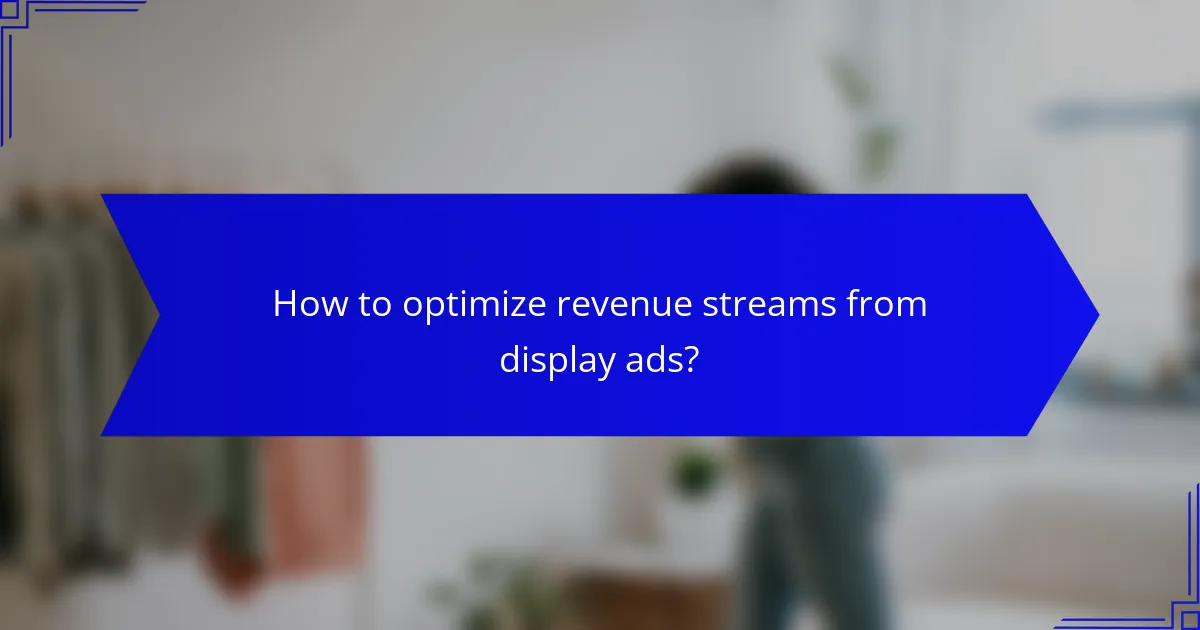Monetization strategies are essential for maximizing revenue through display advertising, with options such as programmatic advertising, affiliate marketing, and sponsored content. Various platforms like Google AdSense and Facebook Audience Network provide tools for publishers to effectively manage ad placements and optimize earnings. By focusing on strategic ad placements and user engagement, publishers can significantly enhance their revenue streams.

What are effective monetization strategies for display advertising?
Effective monetization strategies for display advertising include programmatic advertising, affiliate marketing, sponsored content, direct ad sales, and native advertising. Each method has its own mechanics, advantages, and considerations that can significantly impact revenue generation.
Programmatic advertising
Programmatic advertising automates the buying and selling of ad space, allowing advertisers to target specific audiences efficiently. This method uses algorithms and data analytics to optimize ad placements in real-time, often resulting in higher engagement rates.
To implement programmatic advertising, consider using platforms like Google Ad Manager or The Trade Desk. Monitor key performance indicators (KPIs) such as click-through rates (CTR) and return on ad spend (ROAS) to assess effectiveness.
Affiliate marketing
Affiliate marketing involves partnering with brands to promote their products or services, earning a commission for each sale generated through your display ads. This strategy is particularly effective for niche websites with a dedicated audience.
To succeed in affiliate marketing, choose products that align with your audience’s interests and ensure transparency about affiliate relationships. Popular affiliate programs include Amazon Associates and ShareASale, which provide various tools to track performance.
Sponsored content
Sponsored content features articles or posts that promote a brand while providing value to the reader. This method blends advertising with editorial content, making it less intrusive and often more engaging.
When creating sponsored content, ensure that it aligns with your site’s tone and audience preferences. Clearly label sponsored posts to maintain transparency and comply with advertising regulations.
Direct ad sales
Direct ad sales involve negotiating contracts with advertisers to sell ad space on your website. This approach can yield higher profit margins compared to programmatic sales, as you set the rates and terms.
To effectively manage direct ad sales, develop a media kit outlining your audience demographics, traffic statistics, and ad placement options. Regularly update this information to attract potential advertisers.
Native advertising
Native advertising integrates ads seamlessly into the content, matching the form and function of the surrounding material. This strategy enhances user experience and can lead to higher engagement compared to traditional display ads.
When implementing native ads, ensure they are relevant to your content and audience. Platforms like Taboola and Outbrain can help distribute native ads effectively while maintaining compliance with advertising standards.

Which platforms support display advertising monetization?
Several platforms facilitate display advertising monetization, allowing publishers to earn revenue through ad placements. Key players in this space include Google AdSense, Facebook Audience Network, Amazon Publisher Services, and AdRoll, each offering unique features and benefits.
Google AdSense
Google AdSense is one of the most popular platforms for display advertising monetization, enabling website owners to earn money by displaying targeted ads. Publishers can sign up for free and integrate AdSense into their sites, where ads are automatically matched to the content and audience.
To maximize earnings, focus on optimizing ad placements and ensuring high-quality content that attracts traffic. AdSense operates on a pay-per-click (PPC) model, meaning you earn money each time a user clicks on an ad, with average earnings typically ranging from a few cents to several dollars per click, depending on the niche.
Facebook Audience Network
Facebook Audience Network allows publishers to monetize their apps and websites by displaying ads from Facebook advertisers. This platform leverages Facebook’s extensive user data to deliver highly targeted ads, which can lead to higher engagement and conversion rates.
To participate, you need to integrate the Audience Network SDK into your app or website. Keep in mind that while the potential for revenue is significant, competition can be high, and ad formats may vary, including banner ads, interstitials, and native ads.
Amazon Publisher Services
Amazon Publisher Services offers a suite of tools for publishers to monetize their content through programmatic advertising. This platform connects publishers with advertisers looking to reach specific audiences, leveraging Amazon’s vast data resources.
Using Amazon Publisher Services can enhance your revenue through features like header bidding and real-time bidding. Publishers should consider the technical setup required and the potential for higher earnings through competitive ad placements, especially in e-commerce-related niches.
AdRoll
AdRoll specializes in retargeting and display advertising, helping businesses reconnect with users who have previously interacted with their site. This platform is particularly effective for driving conversions by displaying ads to users across various websites and social media platforms.
To get started, you need to set up an AdRoll account and install their tracking pixel on your site. Focus on creating compelling ad creatives and segmenting your audience for better targeting. AdRoll operates on a cost-per-impression (CPM) or cost-per-click (CPC) basis, making it essential to monitor performance metrics to optimize your campaigns effectively.

How to optimize revenue streams from display ads?
To optimize revenue streams from display ads, focus on strategic placements, data analysis, and user engagement. Implementing effective techniques can significantly enhance ad performance and increase overall earnings.
A/B testing ad placements
A/B testing ad placements involves comparing two or more variations of ad positions to determine which performs better. By rotating ad placements, you can identify the optimal locations that yield higher click-through rates (CTR) and conversions.
Consider testing different areas of your website, such as the header, sidebar, or within content. Track performance metrics like impressions and engagement to make data-driven decisions on where to place ads for maximum revenue.
Utilizing analytics tools
Analytics tools are essential for understanding how users interact with your ads. By leveraging platforms like Google Analytics, you can gain insights into user behavior, demographics, and ad performance.
Monitor key metrics such as CTR, bounce rates, and average session duration. This data will help you refine your ad strategy, targeting specific user segments that are more likely to engage with your ads and generate revenue.
Improving website load speed
Website load speed directly impacts user experience and ad performance. A faster-loading site can lead to lower bounce rates and higher engagement, which in turn boosts ad revenue.
Aim for load times under three seconds, as users tend to abandon sites that take longer. Optimize images, leverage browser caching, and minimize HTTP requests to enhance speed and keep visitors on your site longer.
Enhancing user experience
Enhancing user experience is crucial for maximizing revenue from display ads. A seamless and enjoyable browsing experience encourages users to stay longer and engage more with your content and ads.
Focus on intuitive navigation, mobile responsiveness, and relevant content. Avoid intrusive ads that disrupt the user experience, as they can lead to higher bounce rates and lower overall ad performance.

What are the key criteria for selecting a monetization platform?
When selecting a monetization platform, consider factors such as revenue share models, ad format compatibility, and alignment with your target audience. These criteria will help ensure that the platform not only generates revenue but also fits seamlessly with your content and audience preferences.
Revenue share models
Revenue share models determine how earnings are split between you and the platform. Common arrangements include fixed percentages, tiered structures, or flat fees based on performance metrics. For example, a platform might offer a 70/30 split, where you keep 70% of the revenue generated from ads.
Evaluate the model that best aligns with your content strategy and audience engagement. Some platforms may offer higher shares for premium content, while others might incentivize volume over quality. Always read the fine print to understand any conditions that could affect your earnings.
Ad format compatibility
Ad format compatibility refers to how well the platform’s ad types integrate with your content. Different formats, such as display ads, video ads, or sponsored content, can impact user experience and engagement. Choose a platform that offers formats that resonate with your audience and fit your content style.
For instance, if your content is primarily video-based, look for platforms that specialize in video ads or offer seamless integration with video players. Testing various formats can also help identify which ones yield the best results for your specific audience.
Target audience alignment
Aligning with your target audience is crucial for effective monetization. A platform that caters to your audience’s interests and demographics can significantly enhance engagement and revenue potential. Analyze the platform’s user base to ensure it matches your audience’s characteristics.
For example, if your content targets young adults, consider platforms that are popular among that demographic. Additionally, explore platforms that offer audience insights and analytics to help you tailor your content and advertising strategies effectively.
